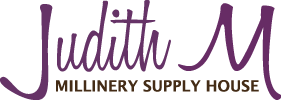Due to a leaky roof at the shop, I have been spending time going through stacks of papers as I re-file things. What follows are random tidbits of useful information I’ve rediscovered.
Creating a bias sinamay strip for a brim – cut strip of sinamay on the bias twice the desired finished width of binding, plus 1/8″ extra to go over the wire edge. Fold strip in half lengthwise and gently stretch around raw edge of brim on right side while pinning in place. Topstitch by hand or machine along the right side of this bias strip. Turn under folded edge to wrong side of brim and hand stitch in place using a single thread. Tip: running bias strip around edge of ribbon board first might save time and ease the process.

Removing a stain on straw – If an organic stain, dab with hydrogen peroxide and blot from both sides until almost dry. After straw is completely dry, if the stain remains, repeat. If the stain is chemical based, try a dry cleaning solvent.
Removing glue (e.g., when stripping off an old hatband) – lay a sheet of tissue paper over the glue area and apply low dry heat from iron. Gently move tissue over spot and repeat until most of the glue has been absorbed by the tissue. Then brush the nap (or surface) to remove rest.
Smoothing a Felt Brim Edge – To make the raw edge of a brim smooth, gently brush along the edge with light sandpaper, emery board or wire bristle brush. This leaves a clean appearance.

Acid-free Tissue – There are two types of acid-free tissue, buffered and unbuffered.
- The buffered tissue is opaque white and has a slightly chalky feel. This is due to the buffering agent, known as calcium carbonate, that is added to the paper to prolong its acid-free quality. Many people like that it has a certain amount of bulk when crumpled, which allows for padding ad bolstering. You can safely use this paper for all textile storage needs.
- Unbuffered tissue is also acid-free, but does not have the acid buffers or an acid reserve. It is softer to the touch and more fibrous in appearance. It was developed specifically for use with silk and wool textiles, in case the calcium carbonate in the buffered product could be harmful to these materials. (There has been no published verification of any damage caused by buffered acid-free paper to textile protein materials). Because of its softer texture it can be used with the most fragile textiles that might otherwise be harmed by sharp creases or edges in the buffered tissue.
- Tyvek is an acid-free product but thought too expensive to use as layering tissue. It does make a good outer covering, or storage tray support.
Note: Thank you to Regional Alliance for Preservation for this information on acid-free tissue.

